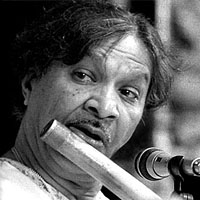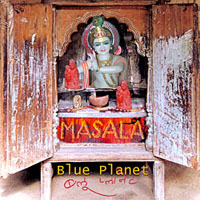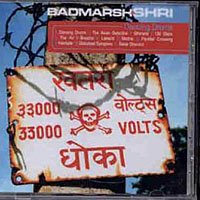alan little’s weblog
indian classical music
27th May 2004 permanent link
Indian Traditional Arts Part Three – in which Alan draws grandiose conclusions from his minuscule knowledge of Indian classical music, and contrasts them with his slightly less minuscule knowledge of western classical music.
So far I’ve talked about stone carving, where people seem to be quite happy to follow traditional styles and see no need for innovation; and yoga teaching, where I strongly suspect there was quite a lot of innovation and pioneering going on quite recently but people seem to like to pretend there wasn’t. But now we come to Indian classical music, which seems to be very much alive and thriving (in contrast to the current state of western classical music) – and also (possible causal connection here) absolutely buzzing with change and innovation that everybody seems to be quite open about.
I first started listening to Indian music through young classically trained Indian musicians playing stuff that combines traditional music with modern western dance music: Talvin Singh, Badmarsh & Shri, Blue Planet. This stuff is quite big in Britain these days and London seems to be the epicentre of it (although Blue Planet record on a German label). [I wonder what Indians in the States are up to musically, if anything? Surely not all too busy being doctors and software engineers?]
The fusion stuff is fun. But then when I actually went to India for the second time I started listening to the real thing, and that’s even better.
Hariprasad Chaurasia, Amjad Ali Khan and Rahul Sharma are the guys who have most consistently impressed me from what I’ve heard so far. I’ve seen Chaurasia live, the others I’ve unfortunately only heard on record. I start listening to this stuff and I thought: wonderful, ancient musical traditions. Then I started reading the sleeve notes of my embryonic new CD collection and looking at a few reviews (I’m finding musical nirvana pretty informative), and you discover that they all have reputations as innovators. They’re all playing modified forms of instruments that they’ve designed themselves, or using instruments or instrument combinations that haven’t traditionally been used in classical music.
Chaurasia, a bamboo flute player, is one of the most famous classical musicians in India – but apparently before he came along the flute wasn’t a particularly prominent classical instrument, and the flutes he plays are non-standard ones of his own design.

Hariprasad Chaurasia
Rahul Sharma plays an instrument called the Santoor that was apparently unheard of as a classical instrument until his father made it famous. He himself is noted for some novel hybrid North-South instrumental combinations. (I find this is all quite reminiscent of Beethoven and his unsuccessful struggles to find or design a piano that actually worked to his satisfaction – more on this later). I have a straight classical CD by him that I really like; he has also made a mixed acoustic/electronic trance album, Zen, that I haven’t heard (I bid on it on ebay, unsuccessfully). And – now we get to the really strange-but-fun – an album of Sex Pistols covers called Never Mind the Bhangra with a group called Opium Addiction (I’m assuming this last one is the same Rahul Sharma, the name isn’t terribly unusual).
Ravi Shankar, probably the most famous living Indian classical musician, had one of his early big successes in film music for Satyajit Ray’s legendary Apu Trilogy. And, of course, is more famous in the west for his collaborations with the Beatles and with western classical big names like Yehudi Menuhin and Philip Glass, than for his “straight” Indian classical playing.
A couple of western instruments have been enthusiastically adopted. The violin, borrowed from the British but played very differently from the European way, is now a standard rhythm/accompaniment instrument in south Indian music. The Indian-sounding “mohan veena” is a slide guitar, borrowed from American folk music and made famous by Vishwa Mohan Bhatt. Whereas I don’t recall seeing too many veenas being used in western string quartets, or sarods in blues bands. People play North Indian music in South Indian styles and arrangements, and vice versa. Classical arrangements of film tunes and folk songs seem to be hugely popular.
All this inventing, developing and adapting instruments was in full swing in the golden age of western classical music too. In Bach’s day the violin and cello were just replacing the viola da gamba as the most prominent string instruments. A friend tells me Mozart, whose clarinet quintet is one of his best known and most popular works, was one of the first people to write anything serious for the clarinet. And Beethoven famously complained vehemently about the early pianos that were available in his day, beat the crap out of the ones he played and wrote music that pushed right to the limit of their capabilities.
Glancing through an old yoga book, The Yoga Tradition of the Mysore Palace by Norman Sjoman, in connection with my previous piece on yoga teaching, I find this:
In order to understand the development of the yoga tradition, the nature of tradition itself within the context of Indian arts and scholarship must be examined. The term “tradition” evokes meanings or presuppositions that are often not quite applicable to the Indian context. For example, South Indian Music in its present form is more or less assumed to be a standard form that has origins in the distant past. But forms that were distinctly different, the thaaye, which were performed less than fifty years ago have totally disappeared such that the nature of their performance is completely unknown today. However a manuscript exists in the Madras Music Academy of ninety-eight thaaye-s in full notation. The thaaye again is the source of the modern taanam. Therefore a statement that South Indian Music is fifteen hundred years old could be made and the contrary statement the South Indian Music is less than fifty years old could be made with equal justice
I haven’t finished, but I’ve written more than enough for one weblog posting (and it’s bedtime). So rather than wait until I’ve written some gargantuan Ultimate Everything Compendium, I’m going to post this now with a note that there’s more to come: some CD recommendations, and thoughts on What It All Means.
related entries: Music
all text and images © 2003–2008

